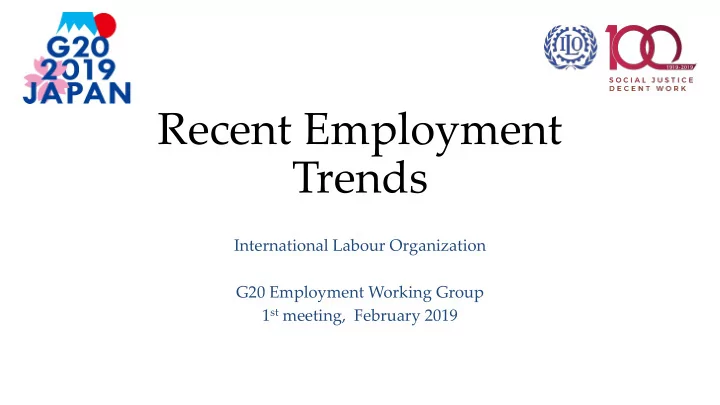

Recent Employment Trends International Labour Organization G20 Employment Working Group 1 st meeting, February 2019
I. G20 labour market overview Source: ILO Modelled Estimates, November 2018. Figures for 2018 are preliminary, 2019-2021 are projections. Age group 15+ years.
II. Labour force participation rate: Overall Declining trends continue … 68 66.8 G20 G20 advanced G20 Emerging 66 65.1 64 62.5 62 61.8 60.4 60.4 60 60.1 59.9 59.3 58 56 2001 2002 2003 2004 2005 2006 2007 2008 2009 2010 2011 2012 2013 2014 2015 2016 2017 2018 2019 2020 2021 Source: ILO Modelled Estimates, November 2018. Figures for 2018 are preliminary, 2019-2021 are projections. Age group 15+ years.
II. Labour force participation rate: Youth and older workers Opposing trends Old-age (55-64) Youth (15-24) 55 70 53.7 G20 G20 advanced G20 Emerging G20 G20 advanced G20 Emerging 53.1 65.5 50 65 50.5 45.8 45.5 45 60 59.3 58.3 44.1 57.0 57.2 43.8 55.5 56.7 39.1 40 55 53.8 37.6 50.5 35 50 2001 2003 2005 2007 2009 2011 2013 2015 2017 2019 2021 2001 2003 2005 2007 2009 2011 2013 2015 2017 2019 2021 Source: ILO Modelled Estimates, November 2018. Figures for 2018 are preliminary, 2019-2021 are projections.
II. Labour market participation: Gender gaps …with different developments in gender gaps between advanced and emerging G20 countries +7% -30% Source: ILO Modelled Estimates, November 2018. Age group 15+ years.
III. Unemployment: Overall I Unemployment rates converge in G20 countries 10 G20 G20 advanced G20 Emerging 9 8.6 8 7 6.7 6 5.6 5.2 5.2 4.9 5 4.8 4.7 4.8 4 3 2001 2002 2003 2004 2005 2006 2007 2008 2009 2010 2011 2012 2013 2014 2015 2016 2017 2018 2019 2020 Source: ILO Modelled Estimates, November 2018. Figures for 2018 are preliminary, 2019-2020 are projections. Age group 15+ years.
III. Unemployment: Youth Major concerns remain NEET Unemployment rate 20 40 G20 G20 advanced G20 Emerging 19 35 18.0 18 30 17 25 16 20 15 15 14 13.6 10 13.5 12.6 13 5 13.0 11.2 12 0 10.9 Female Male Female Male Female Male 11.5 11 10.7 G20 G20 advanced G20 Emerging 10 2001 2004 2007 2010 2013 2016 2019 2009 2019 Source: ILO Modelled Estimates, November 2018. Figures for 2018 are preliminary, 2019-2020 are projections. Age group 15-24 years.
IV. Quality of work: Real wage growth 10 9.4 Annual average real wage growth (%) 8 6.9 6.8 6.5 6.3 5.7 6 4.9 4.4 4.4 4.3 3.8 4 3.6 3.0 3.0 2.9 2.9 2.7 2.3 2.2 2.1 2.1 2.0 1.9 1.8 1.7 2 1.0 0.9 0.7 0.6 0.6 0.4 0.4 0.4 0.2 0 -0.3 -0.9 -2 2007 2008 2009 2010 2011 2012 2013 2014 2015 2016 2017 2018 G20 advanced G20 emerging G20 Source: ILO estimates based on official national sources as recorded in the ILO Global Wage Database. Figures for 2018 are preliminary.
IV. Quality of work: Gender pay gap No significant improvement Factor weighted mean Gender Pay Gap 30 25 20 % 15 10 5 0 around 2010 around 2016 Source: ILO estimates using household and labour force surveys. For all countries we use the two available points in time that allows for a more harmonious comparison; in most countries these are 2010 for the earlier and 2015 or 2016 for the latest year. The exceptions are China (2007 and 2013), Republic of Korea (2009 and 2016) and Russian Federation (2013 and 2015). For the EU all estimates are based on the Structure of Earnings survey and for that the latest year is 2014.
V. Ageing: Median age of the labour force 45.0 44.0 44.1 43.0 43.0 42.5 41.8 41.9 41.3 40.7 40.3 Median age (Years) 39.9 39.5 40.0 37.9 37.3 34.7 35.0 33.6 33.6 32.1 30.0 Female Male Female Male Female Male G20 G20 advanced G20 Emerging 1991 2019 2030 Source: ILO Modelled Estimates, November 2018; UN World Population Prospects, 2017.
V. Ageing: impact on GDP per capita growth Demographic change will lower GDP per capita growth 1 Impact on per capita growth (per cent) 0.8 0.6 0.4 0.2 0 -0.2 -0.4 -0.6 1990-2000 2000-2010 2010-2020 2020-2030 1990-2000 2000-2010 2010-2020 2020-2030 G20 emerging G20 advanced Unemployment 65+ dependency 15-64 dependency Child dependency Total Source: ILO Modelled Estimates, November 2018; UN World Population Prospects, 2017.
Recommend
More recommend